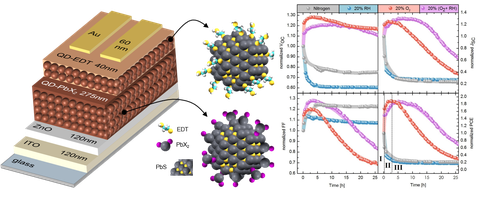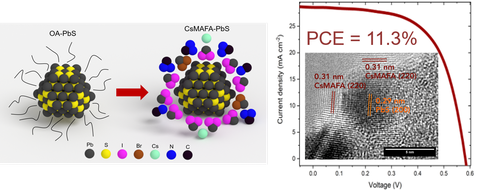PbS Quantum Dots
Since their first introduction in 2008, lead sulfide (PbS) quantum dot (QD) photovoltaic devices have been under extensive investigation leading to record power conversion efficiency of 12.24%. One of the key advantages of quantum dots stems from their nano-character, which allows tuning their optoelectronic properties by choosing their size, shape and ligands. This multifunctionality has led to the realization that QDs can be used as both an active layer and as an extraction layer, providing appropriate ligands are selected. In particular, PbS QDs with 1,2-ethandithiol (EDT) ligands have become ubiquitously employed as a hole extraction layer in PbS quantum dot photovoltaic devices, including those with record efficiency, in which PbI2 ligands are used in the device active layer. Our work in the field of PbS quantum dot photovoltaics follows two main avenues:
Stability: A unique trait of quantum dot solar cells is that unlike other types of solution-processed devices, e.g. organic or organic-inorganic perovskite, quantum dot solar cells can experience an increase in performance upon exposure to the environment. Consequently, it has become routine in literature to perform preconditioning procedures, such as exposure to air prior to photovoltaic characterization, however the exact mechanism of this improvement remained unclear. Recently, we have identified that the improvement in performance stems from the difference in oxidation dynamics between quantum dots coated with different ligands. While PbI2-PbS dots show only minor changes in their composition and optical properties, the EDT-PbS quantum dots show a gradual decrease in size due to the formation of a shell of oxidation products. As a result, the increased bandgap of EDT-PbS enhances the efficiency of electron blocking by the EDT-PbS layer, drastically improving the device efficiency.

Adopted from Sustainable Energy Fuels 2020, 4, 108-115.
Perovskite-PbS core-shell structures: The excellent match between the atomic lattice constant of PbS and perovskites offers the possibility to synthesise a broad range of perovskite coated PbS quantum dots that are of interest for application in near-infrared absorbing photovoltaic devices. We investigate the role of perovskite shell composition on the properties, performance and stability of these devices. Recently, we demonstrated that triple cation perovskite shell is superior to the traditional methylammonium lead triiodide, resulting in a simultaneous enhancement in efficiency and stability.

Adopted from ACS Nano 2020, 14, 1, 384-393.
